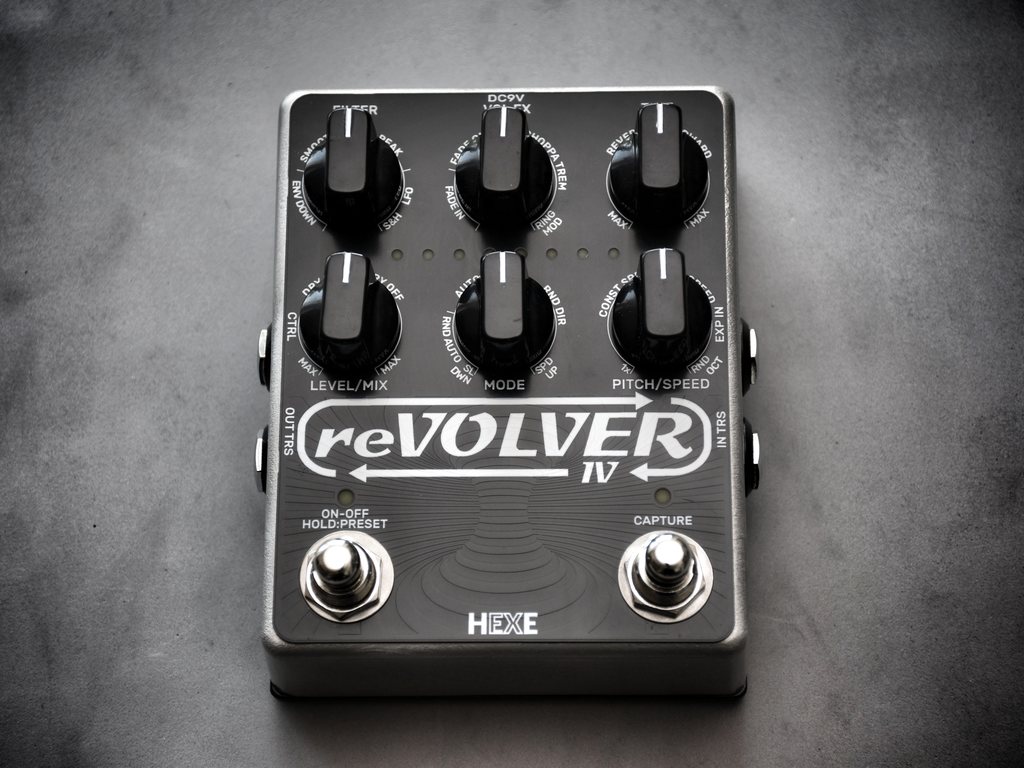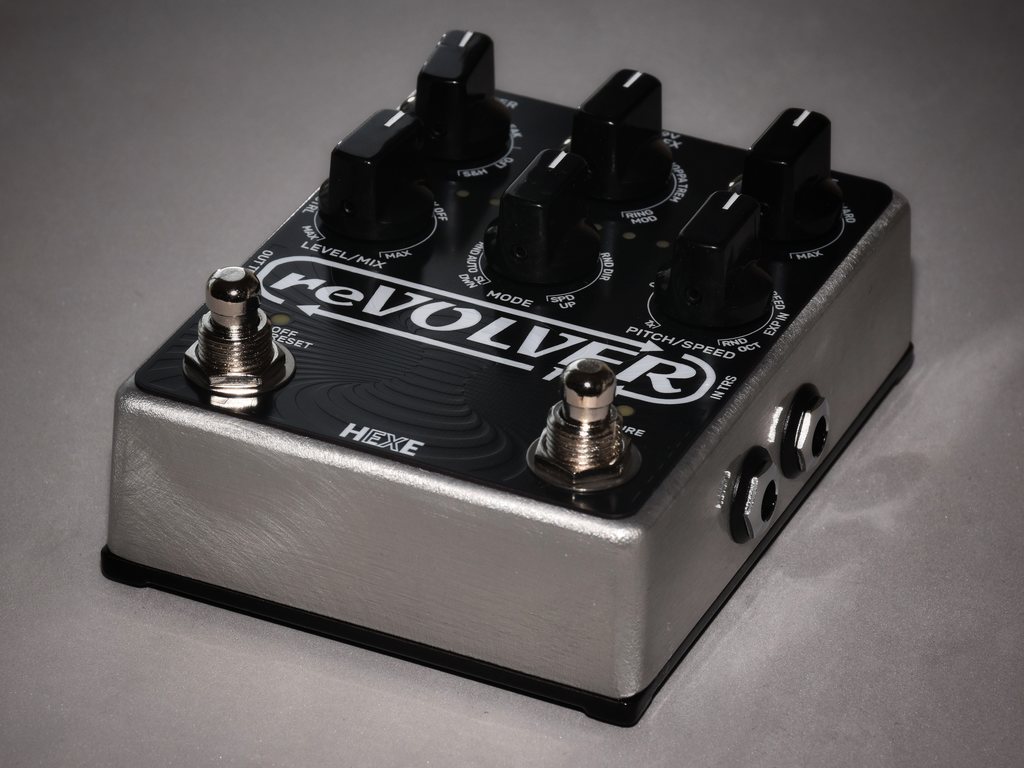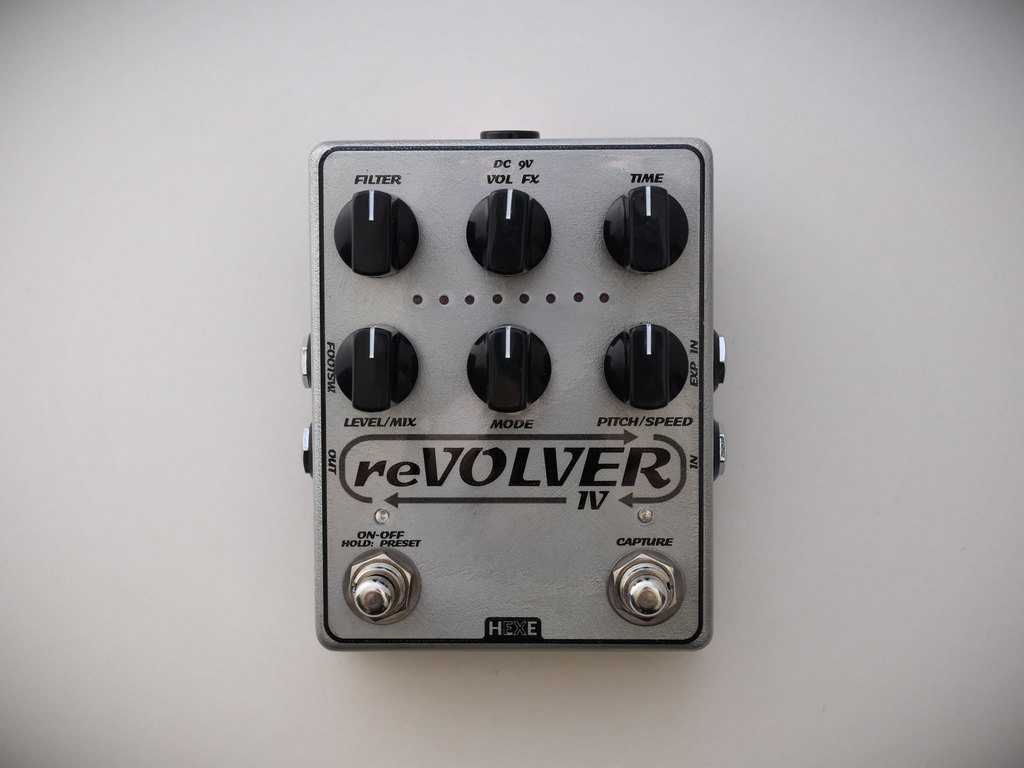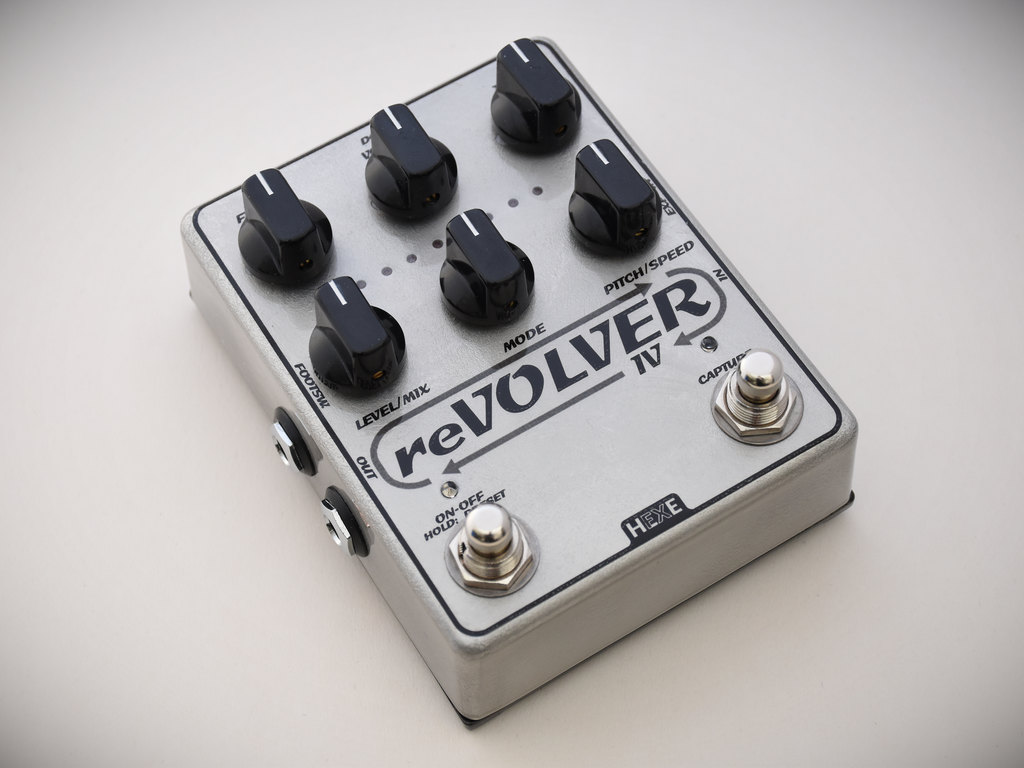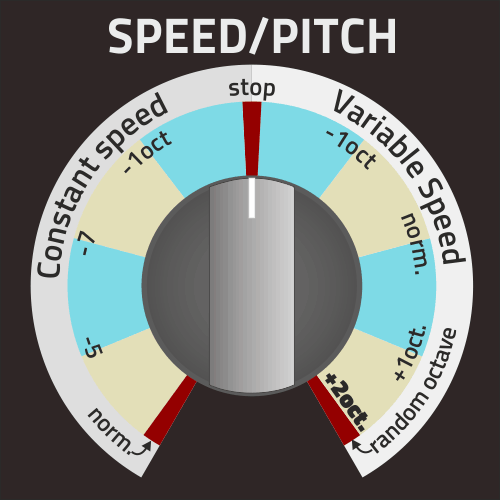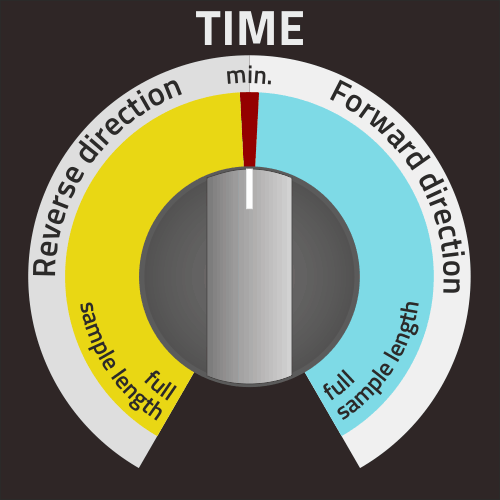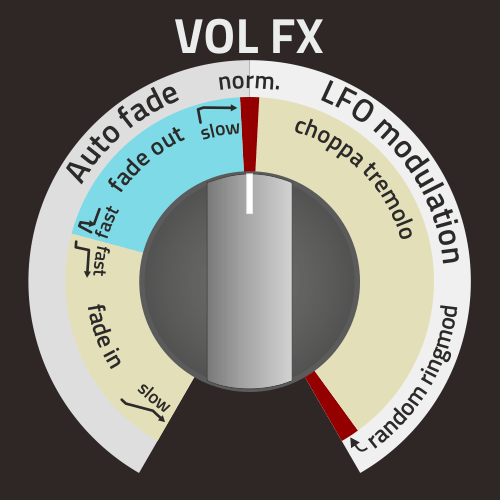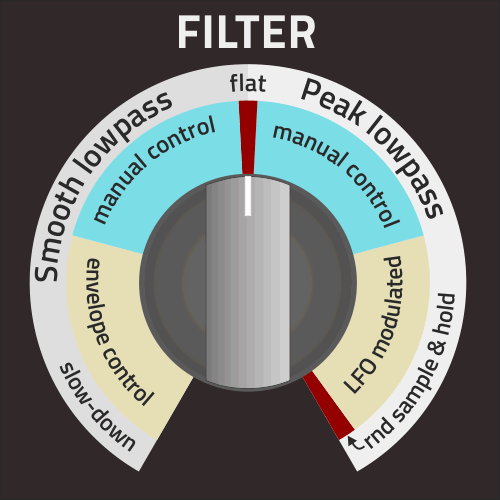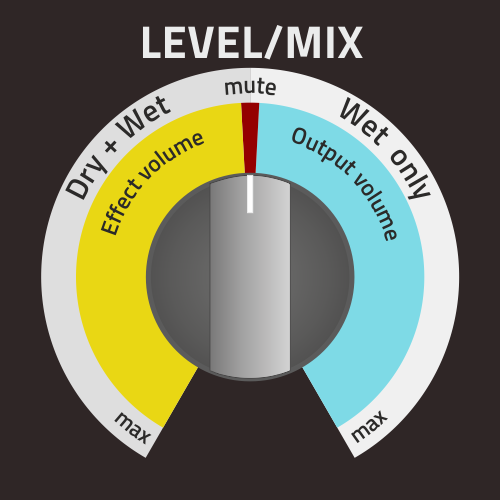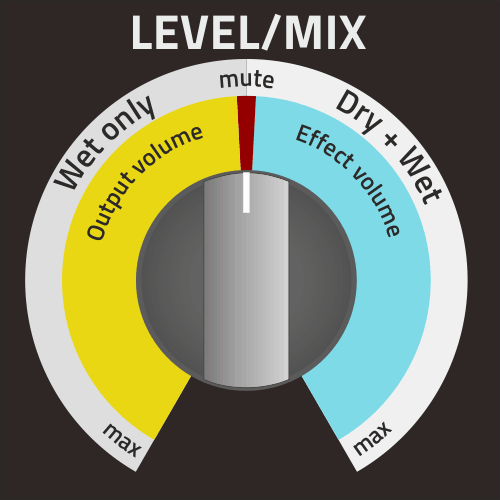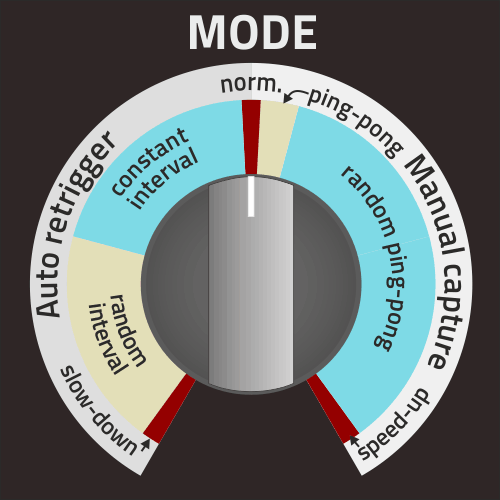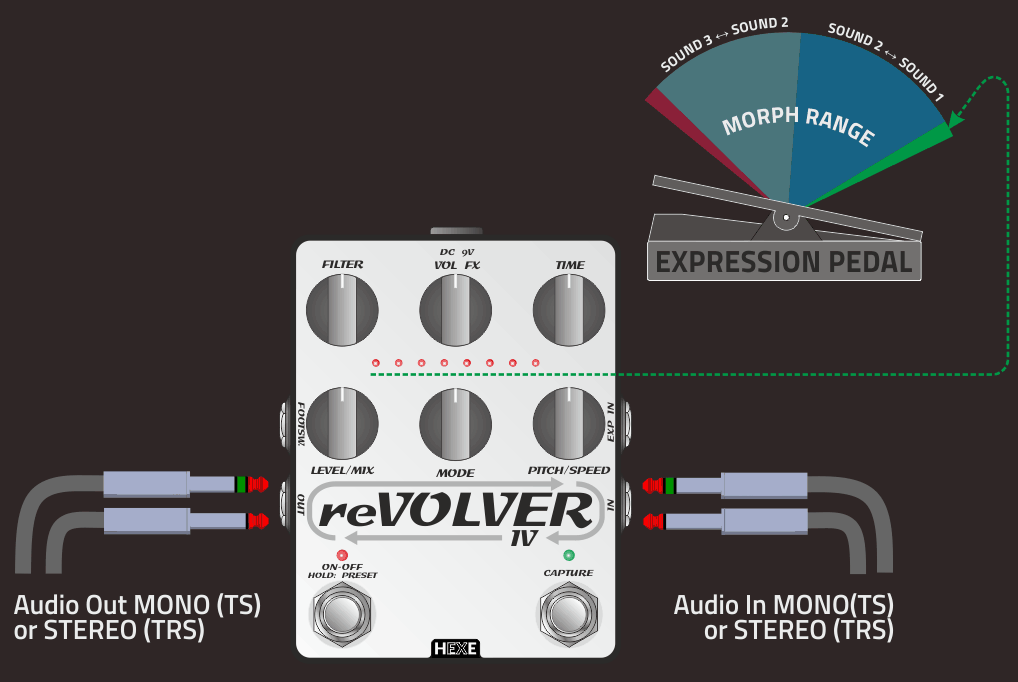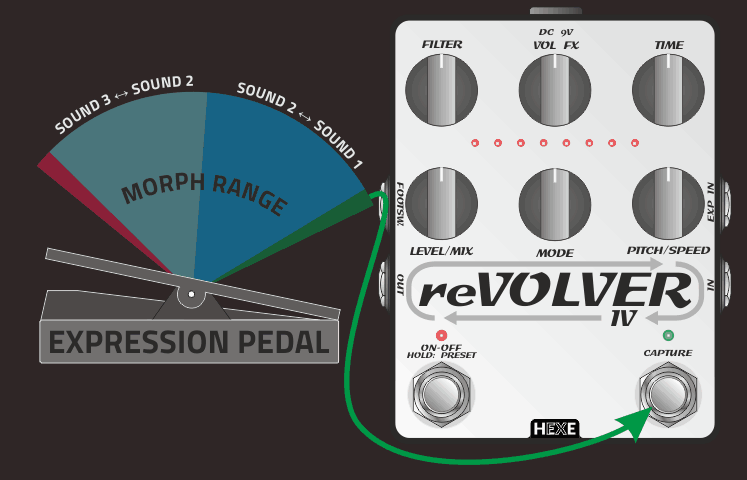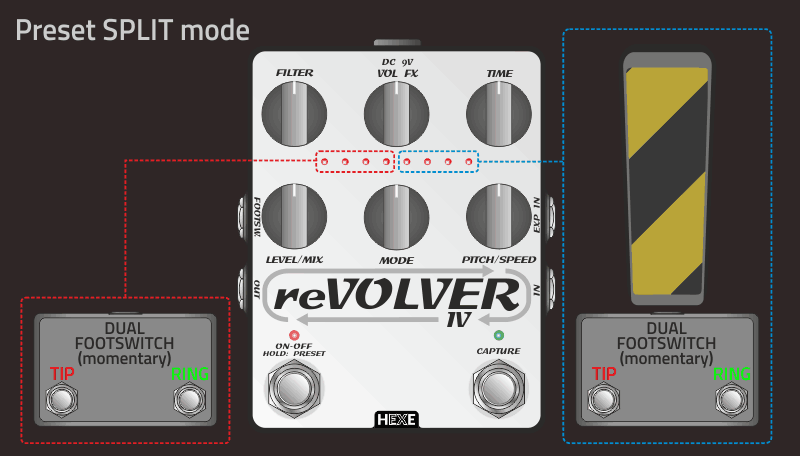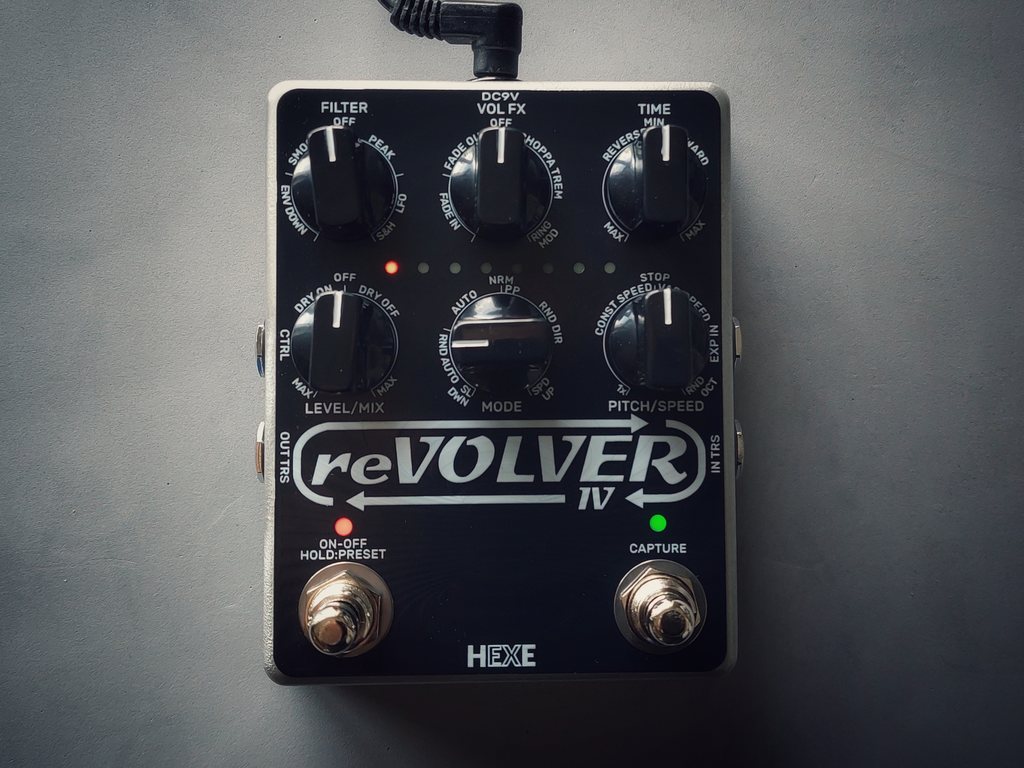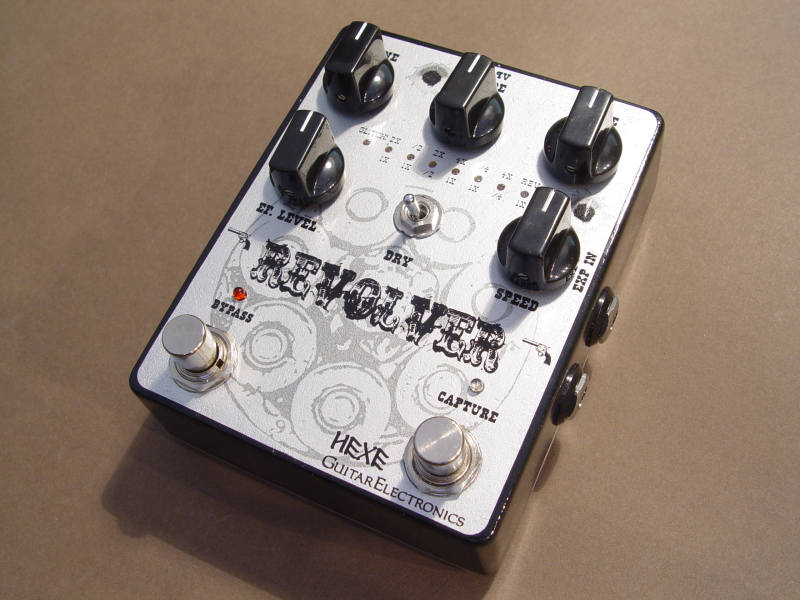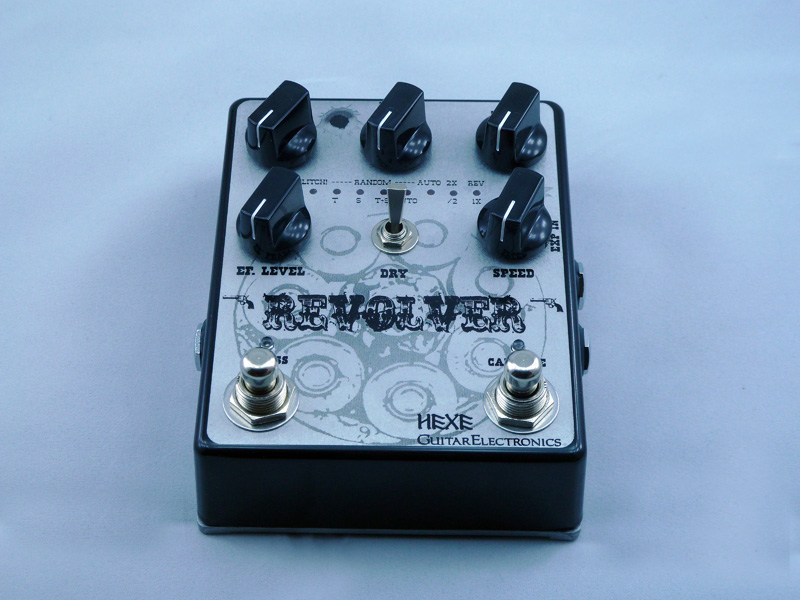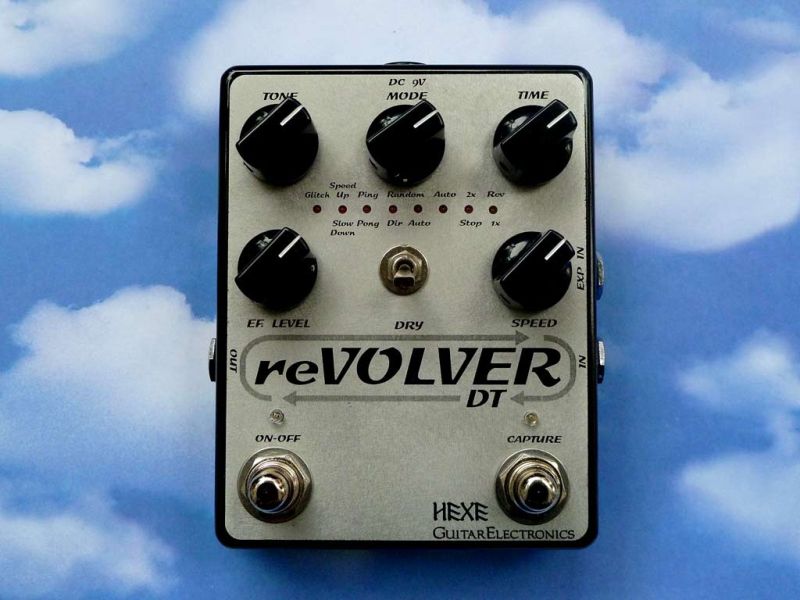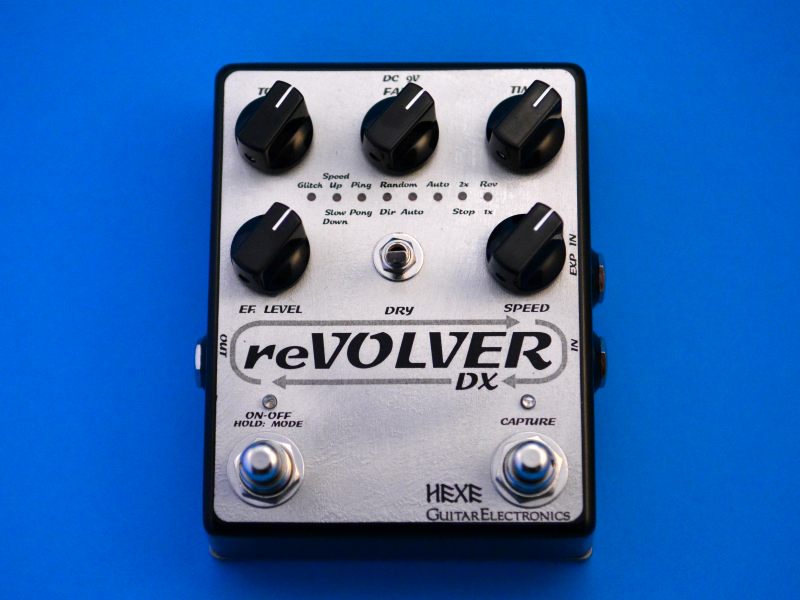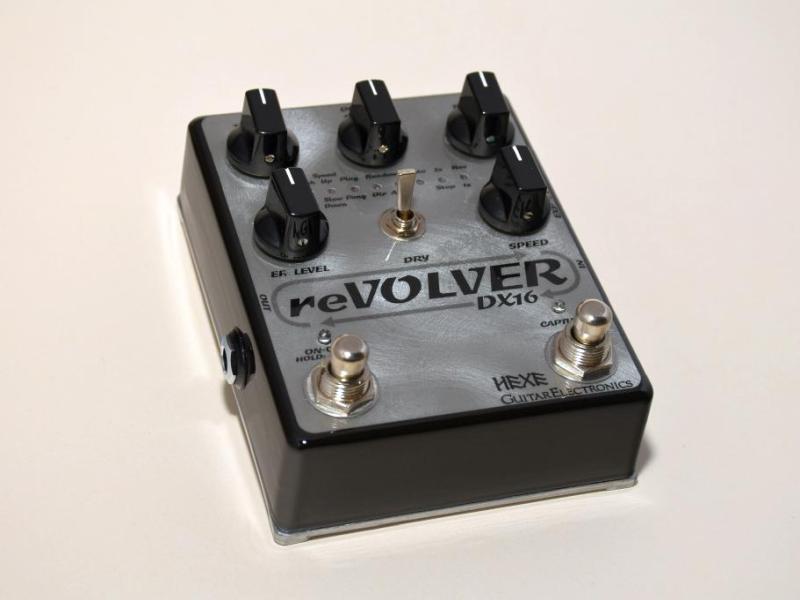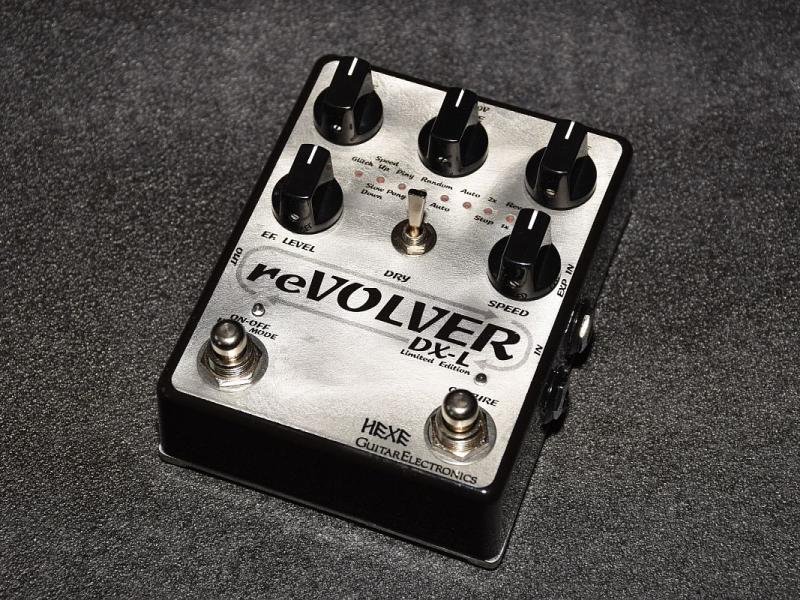Micro looper / sound explorer pedal.
Continuing the reVOLVER legacy, the model IV comes with stereo in and outs, 47 seconds sample buffer, more built in effects and highly interactive control options.
General concept:
reVOLVER IV, as it's predecessors is a highly interactive sampler pedal. Expanded to full stereo and much better sound quality compared to previous models, it brings many new tools to modify and transform the samples into creative background tracks, additional sound layers, rhythmic drone bass tracks and more. The maximum sample length, limited by the memory size is 47 seconds of stereo audio material. A new sample can be played forwards, backwards, the length of the sample can be changed in both directions.
The way the samples are taken has changed a little bit when compared to the previous DX model.
For the new reVOLVER IV, the upper limit of the sample length is the max buffer size, 47 seconds. The moment the Capture is released, the TIME knob range is rescaled to the actual length of the recorded sample, thus giving a more detailed control over this parameter. The same knob can be used to reverse the play direction.
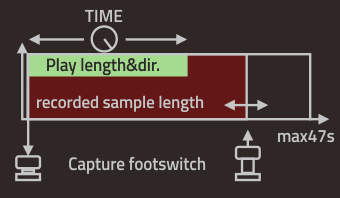
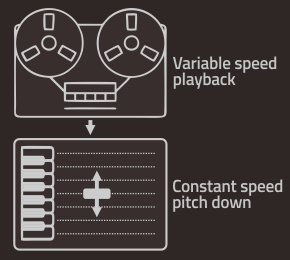
The new sample is then run through two types of pitch shifter, one being a pitch down constant speed one, the other resembling a tape speed control where the sample pitch is directly linked to it's length. The variable speed pitch shifter operates in range from full stop to x4 (+2 octaves pitch change). Both pitch shifter ranges offer a few small dead zones around musical intervals for easier dialing in. A random octave mode, where the natural pitch or one octave below is randomly chosen on each loop iteration adds to the pallete of tools.
The next step is the filter section. reVOLVER IV uses a lowpass filter here. The knob is split in two ranges, the left side being a smooth lowpass filter, similar to a typical "Tone" knob, useful for generic darkening of the signal. This side offers a special mode - an envelope controlled portion, which acts as a lowpass based ducker, darkening the loop depending on the input signal amplitude. This feature is especially useful in improvising situations, helping to bring the main lead sound ontop of the played loop.
The second half of the control is a peak lowpass filter, much more pronounced and useful in any "wah pedal" like scenarios. This range smoothly goes into LFO controlled filter with modulation range spanning from 10mHz to 20Hz. The end station is another FX range on the filter knob: a random sample & hold filter with it's corner frequency updated on each "event" - restarting the loop or flipping the play direction.
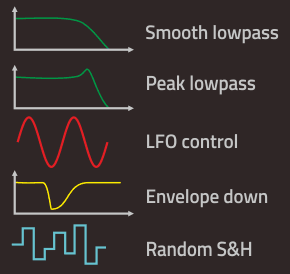
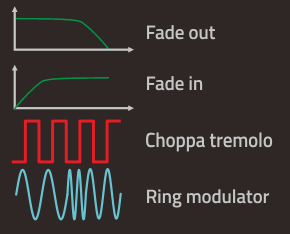
Following the filter is the volume modulation section. This section is similar to the "Fade" control, used in the previous reVOLVER DX model, offering automatic Fade In and Fade Out with the time controlled by the knob. What's new is the right side of the knob: so called "choppa" tremolo. A square wave tremolo excellent to create pulsing and rhythmic patterns out of the recorded sample. At it's max speed it reaches a ring modulator frequencies and ends in one - a random ring modulator, which updates each frequency on each "event", the same way the sample & hold filter does it making them synchronized.
Before the sample reaches the output jack it gets mixed with the incoming, original dry signal. As in previous models, the dry signal path is fully analog and bypasses all the digital part. This way the original tone is preserved and no latency is introduced. The Level/Mix knob has a bit non standard layout specifically to make a transition or switching between the wet only signal (loops) or the loops mixed with the dry signal possible without any kind of toggle switch. Thus making it programmable, which brings up the next topic:
Interactiveness and controllability:
All these features are nice, but without a way to make use of them hands free in live situation they'd be useless. To cope with that reVOLVER IV has 8 highly configurable presets and advanced external control options: an expression pedal and/or a dual footswitch.
One preset can be programmed to morph the sound between 3 different sounds (made of a snapshot of all knobs) and in addition to switch in two more sounds at the heel and toe positions. This gives an access to any kind of sound or modulation that can be done using knobs directly on the expression pedal. Ontop of that, the heel position of the rocker pedal can be programmed to act as the Capture footswitch for quick sampling without removing the foot from the expression pedal.
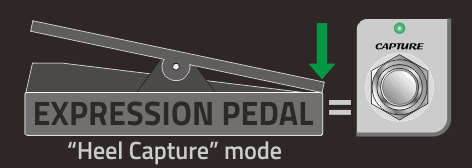
A dual momentary footswitch plugged using a TRS cable adds more. In default mode it emulates jumping to the expression pedal's middle position or the toe position. This can be used for quick sound modifiers, adding modulation, reversing the play direction etc. Both external footswitches can be individually configured as latching or momentary, per preset. The external footswitch can work together with the expression pedal. For situations, where some presets work better with the footswitch only and the others with the expression pedal, there is a special Preset Split Mode, simply disabling the expression pedal for the 1st four presets.
The second working mode for the external footswitch is a "Mirror" mode. If enabled it makes the external footswitch work as remote control. Useful in situations where the pedal is placed on a table, but triggered using feet. There has been a few custom reVOLVER models in the past having a separate jack for a second pair of On-Off and Capture switches. This option is currently built in.
Using with different instruments:
While having a form of a guitar pedal, reVOLVER IV can be used as a generic effect device with many different signal sources. The input gain of the pedal can be adjusted for many sources, including passive low output pickups or a line level signal. Unfortunately not including microphones, as they usually need a dedicated balanced low Z input. For use with voice or direct mic signal, a separate microphone preamp with effect loop is a definitely a good idea.
reVOLVER IV - previous revisions (pre 07.2025)
reVOLVER IV vs reVOLVER DX:
| Feature | reVOLVER DX | reVOLVER IV |
|---|---|---|
| Singal path | Mono | Mono/Stereo |
| Bypass type | Relay based true bypass | Relay based true bypass (stereo) |
| Dry signal path | Analog | Analog |
| Wet signal path | Digital, 12bit 32kHz | Digital, 16bit 44.1kHz AD/DA, 32bit internal precision |
| External controls | Expression pedal (TIME knob) | Fully programmable expression pedal with 8 presets. Dual footswitch with optional mirror mode, replicating the onboard footswitches |
| Filter section | Lowpass + highpass | Smooth lowpass + envelope control, peak lowpass + LFO control, random sample&hold |
| Speed/Pitch | Variable speed only | constant speed (pitch shifter), variable play speed |
| Additional effects | None | Random sample&hold filter, random ring modulator, random octave jump, "choppa" tremolo |
| Presets | None | 8 available, each preset can store up to 5 different sounds and sweep between them using an expression pedal |
Controls:
PITCH/SPEED | TIME | VOL FX | FILTER | LEVEL/MIX | MODE | FOOTSWITCHES | EXPRESSION PEDAL | EXT FOOTSWITCH
PITCH/SPEED:
Controls the setting for both pitch shifters. To help with the navigation, the status led bar briefly shows knob position when changing the setting.
- Constant speed range: sets the pitch without changing the length of the sample. The range is from natural pitch down to full stop with small dead zones around the -5, -7 semitones and octave down points.
- MID position: full stop.
- Variable speed range: controls the play speed parameter. Dead zones available at -1 octave, natural pitch, +1 and +2 octaves.
- MAX position: activates the random octave mode. The pitch is randomly chosen between 1 octave down (and 2x slower) and the natural pitch.
TIME:
Controls the played sample length and the play direction. The MIN and MAX positions correspond to the full recorded length of the sample. The range is scaled on each new sample capture.
- Range from 0% to 50%: sample length in reverse play mode.
- Range from 50% to 100%: sample length in forward play mode.
VOL FX:
Controls various volume based effects. To help with the navigation, the status led bar briefly shows knob position when changing the setting.
- Range from 0% to 25%: fade in effect.
- Range from 25% to 50%: fade out effect.
- MID position: all volume effects off.
- Range from 50% to 99%: Square wave "choppa" tremolo rate control.
- MAX position: activates the random ring modulator effect.
FILTER:
Controls the filter section on the pedal. To help with the navigation, the status led bar briefly shows knob position when changing the setting.
- Range from 0% to 25%: envelope down smooth lowpass, start cutoff frequency control.
- Range from 25% to 50%: smooth lowpass filter manual control.
- MID position: filter off.
- Range from 50% to 75%: Peak lowpass manual control.
- Range from 75% to 99%: Peak lowpass + LFO, rate control.
- MAX position: activates the random sample&hold filter effect.
LEVEL/MIX:
Controls the wet signal (loop) volume, either with dry signal enabled or disabled.
Revision "E"/2025.
- Range from 0% to 50%: WET signal volume, DRY signal mixed in (analog pass through).
- MID position: WET signal muted.
- Range from 50% to 100%: WET signal volume, DRY signal muted.
Revisions before "E" (pre 07.2025).
- Range from 0% to 50%: WET signal volume, DRY signal muted.
- MID position: WET signal muted.
- Range from 50% to 100%: WET signal volume, DRY signal mixed in (analog pass through).
MODE:
Sets one of the 7 available working modes. The auto retrigger modes require to press the Capture in order to start the process. To help with the navigation, the status led bar briefly shows knob position when changing the setting.
- MIN position: Automatic slow down mode. Can be restarted by changing the PITCH/SPEED parameter.
- Range from 1% to 25%: Auto trigger mode with randomized interval and sample length, which can be further scaled using the TIME knob.
- Range from 25% to 50%: Auto trigger mode with constant interval and sample length (also scaled using the TIME knob) .
- MID position: Normal loop mode.
- Right past the MID position: Ping-Pong mode. The loops is played back and forth.
- Range from 55% to 99%: random Ping-Pong mode, the play direction is randomly reversed with the knob controlling the flip time range.
- MID position: Automatic speed up mode, ends with +2 octaves pitch. Can be restarted by changing the PITCH/SPEED parameter.
FOOTSWITCHES:
ON-OFF:
- Short press: effect on/off (true bypass).
- Hold down: change preset.
CAPTURE:
- Press and hold: start new recording.
- Release: stop recording and play.

EXPRESSION PEDAL:
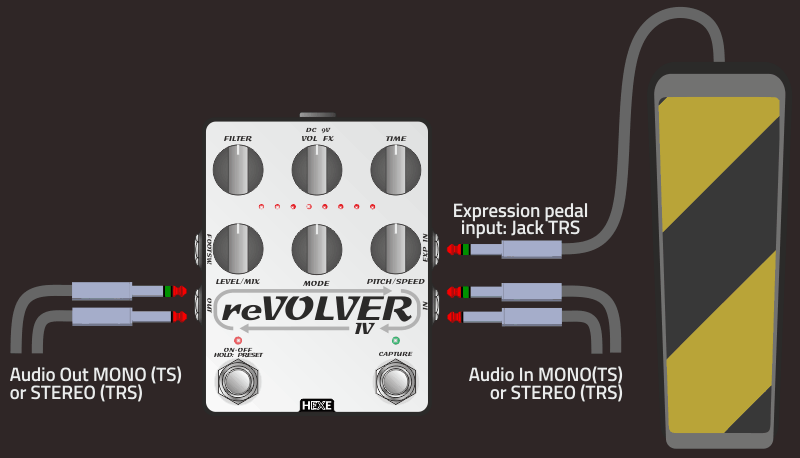
reVOLVER IV can hugely benefit from using it with an expression pedal. Adding it extends all the 8 presets with up to 5 different sounds per preset. A special "Heel Capture" mode can be activated making the heel position work as pressing the Capture footswitch.
reVOLVER IV accepts expression pedals with a linear potentiometer (do no use a volume pedal) with values in range 10k-50k Ohm and the following polarity:
- TIP - pot wiper, control signal.
- RING - pot top/max terminal, supply voltage.
- SLEEVE - pot bottom/min terminal, ground.
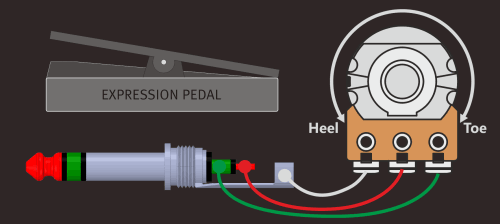
EXTERNAL FOOTSWITCH:
A dual momentary type external footswitch further extends the pedal's toolset. In default mode, the footswitch emulates an instant jump to the expression pedal's toe or middle position. This can be used as quick sound modifier, applied even if the expression pedal is plugged in. Both footswitched can be configured as latching or momentary individually for each of 8 presets.
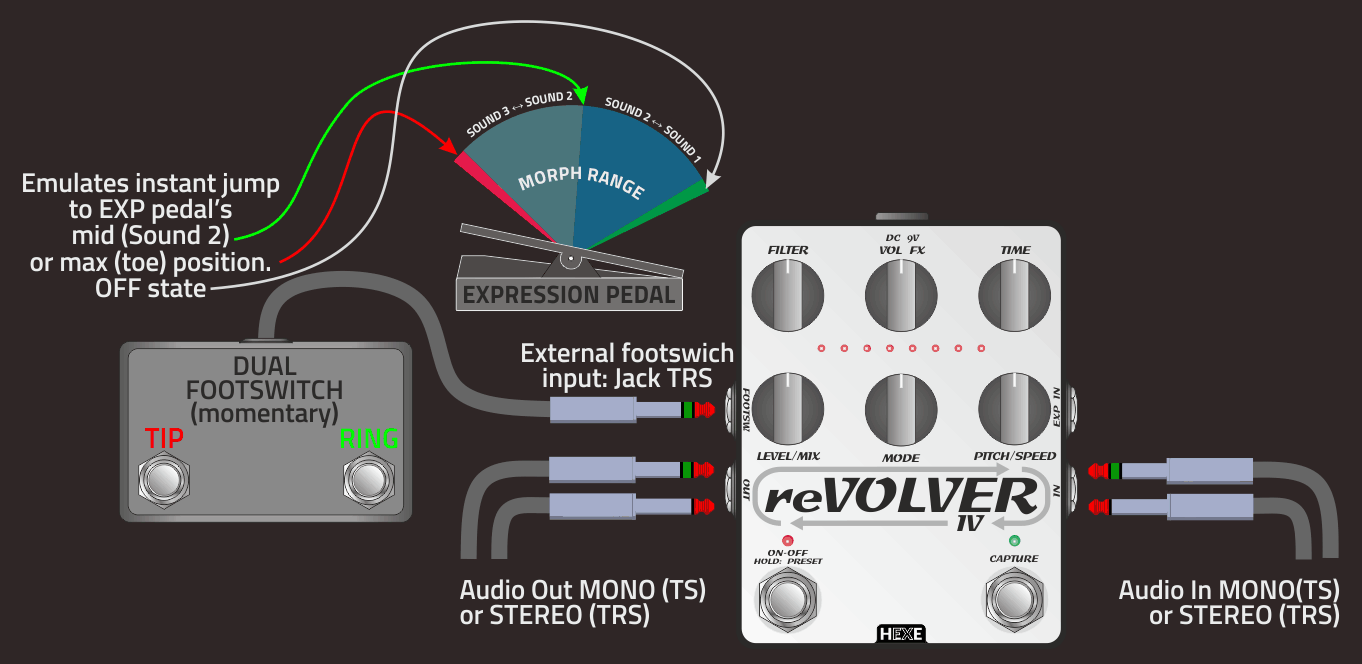
The second mode is the "Mirror" mode, where the external footswitch duplicates the operation of the onboard ON-OFF and CAPTURE footswitches.
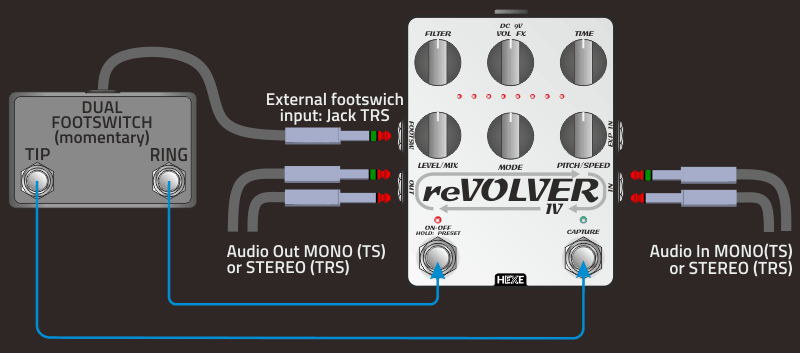
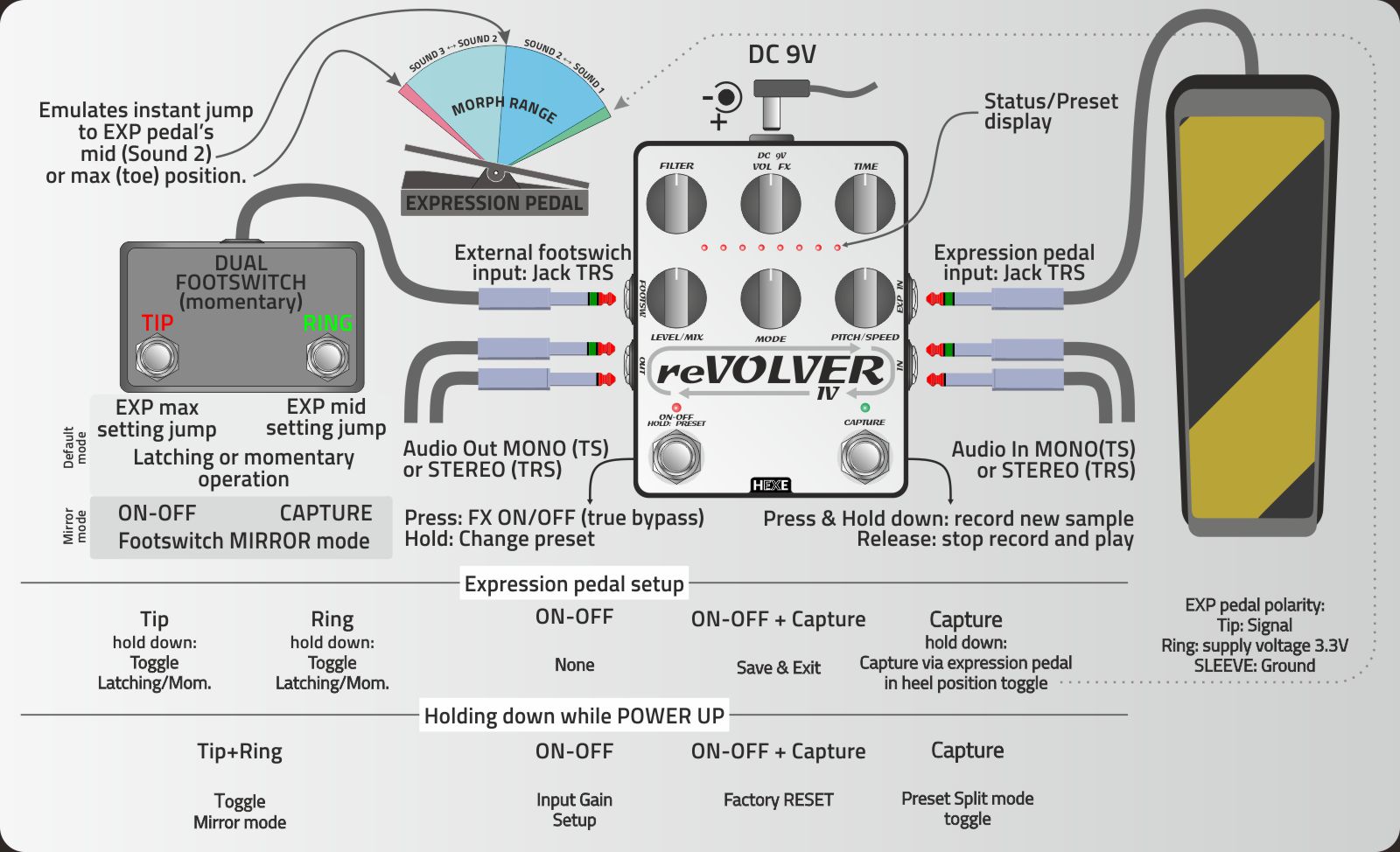
Audio inputs and outputs
Both input and output jacks on the reVOLVER IV are stereo TRS connectors. Pedal can be used in mono applications using TS jacks, too. However this configuration does not work as stereo splitter. A mono input jack will result in mono output only.
Recording new sample
- Press and hold down the CAPTURE footswitch, recording starts indicated by the green LED being lit.
- Release the CAPTURE footswitch to stop the recording and play the new sample. The range of the Time knob is rescaled to the new sample length and can be used to change it or reverse the play direction.
- If the CAPTURE footswitch is held down for longer than the maximum 47 seconds, pedal will stop recording and play the sample.

Reshaping new sample
reVOLVER IV is equipped with a set of tools to modify the newly recorded sample and create often a completely new sound out of it.
Pitch based tools include two types of pitch shifter available on the PITCH/SPEED control. The easy to dial in minimum position of the knob delivers a natural pitch with both blocks turned off. The first half of the knob range is a constant speed pitch down with a few small dead zones around musical intervals, which help with creating harmonic content. The range ends in full stop mode and is followed by variable speed range. This range works similar to a tape speed control (also the same way the SPEED control works on the DX model). The variable speed part has a wider range and can go up to +2 octaves, also providing small dead zones for easier dialing in.
The maximum knob position enables the Random Octave Mode effect.
Time based tools are included in the TIME control. It can be used to shorten the played sample length and change the play direction.
Volume based tools include automatic Fade in, Fade out, a square wave pulse tremolo and a random ring modulator at the end of the VOL FX knob range.
Filter based tools are based on a lowpass filter and offer many ways to shape the sample sound: manually and envelope down controlled smooth lowpass filter, manually and LFO controlled peak lowpass filter. The end of the range enables a random sample&hold filter mode.
Dry/Wet mixer as the LEVEL/MIX knob controls the volume of the sample and whether it is mixed with the dry signal or nor (similar to the DRY switch on the reVOLVER DX).
Working modes, set using the MODE knob. This control is split in two main halves. The left is dedicated for auto retriggering modes, where the pedal can either periodically or randomly record a new sample. The middle range is a standard loop mode, where the sample is continuously repeated, followed by the ping-pong mode - play direction is reversed on each sample boundary. Random ping-pong modes reverse the play direction at randomly chosen points.
The MIN and MAX positions are reserved for two dynamic modes: Speed up and Slow down.
Presets
There are 8 available preset slots for expression pedal settings, multiplying further the number of programmable sounds.
Changing the preset:
- Hold down the ON-OFF footswitch, pedal will enter a preset-change mode indicated by a blinking preset led.
- A steady lit led shows the current preset, keep pressing the ON-OFF footswitch to browse for a new preset, indicated by a blinking led.
- Once a new preset is chosen, press and hold ON-OFF to activate it.
Using presets without any external controllers
If no external controllers are used, each preset will consist of one sound representing the settings for MIN/Heel position of the expression pedal.
Expression pedal use
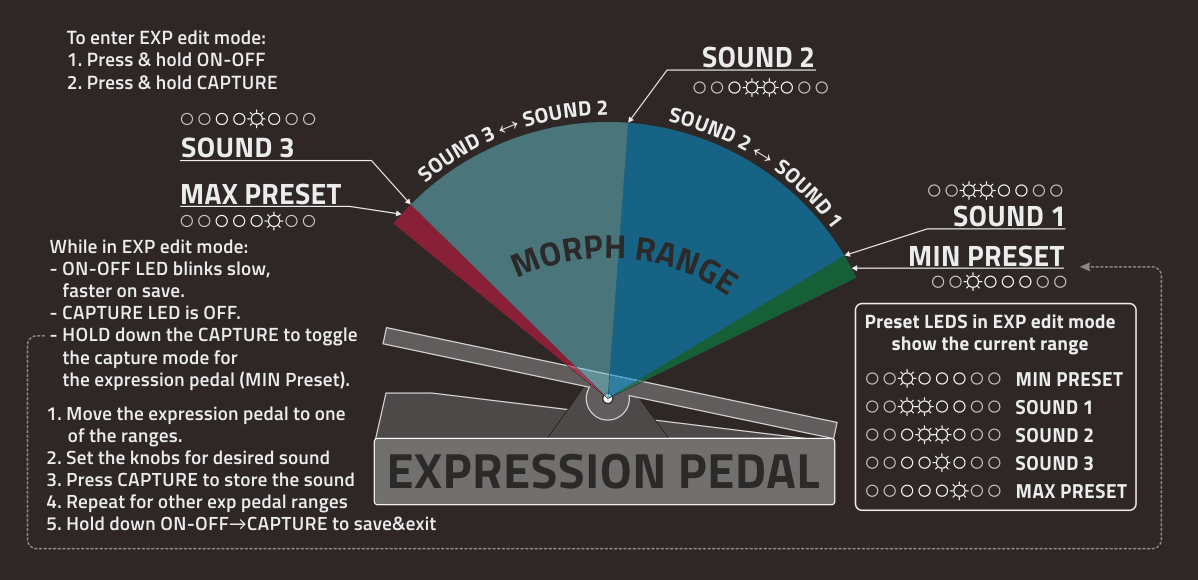
"Heel" Capture mode
This mode, when enabled transforms the heel position of the expression pedal into a second Capture footswitch. Taking a new sample is as easy and quick as moving the exp. pedal back to the minimum position.
To enable/disable the Heel Capture mode:
- Switch to the preset where the change has to be made.
- Enter the Preset Edit mode (Press&hold ON-OFF, then CAPTURE).
- Move the expression pedal to the heel position.
- Press and hold down the CAPTURE footswitch. The change will be confirmed by a few Capture LED blinks.
- Exit the Edit mode to save the new settings.
External footswitch
Editing a preset with external footswitch plugged in
The procedure is very similar to editing a standard preset using an expression pedal, the difference being there is only 3 edit points available: the MIN/Heel position, SOUND 2 (middle position) and MAX/Toe position.
- Entering the Preset Edit mode and saving/exit has to be done using pedal's onboard ON-OFF and CAPTURE footswitches.
- Both external footswitches are in latching mode while editing a preset. An example: press the T-S to set the MAX/Toe range, press again to switch back to the MIN/Heel range.
- Hold down the external footswitch to change it operation from latching to momentary and vice versa. This change will enabled after exiting the preset edit mode.
External footswitch MIRROR mode
To enable or disable the mirror mode:
- Power off the pedal.
- Hold the both external footswitches down and apply the power.
- The change will be confirmed by blinking the opposite leds 1 and 8 on the led bar ⬤◯◯◯◯◯◯⬤
Preset SPLIT mode
Preset SPLIT mode divides the 8 presets in two groups:
- Preset 1-4, external footswitch control only, expression pedal disabled.
- Preset 5-8, both, the external footswitch and the expression pedal enabled.
To enable or disable the mirror mode:
- Power off the pedal.
- Hold down the CAPTURE footswitch and apply the power.
- Switching the Split mode ON will be confirmed on the led bar: ⬤⬤⬤⬤◯◯◯◯
- Switching the Split mode OFF will be confirmed on the led bar: ⬤⬤⬤⬤⬤⬤⬤⬤
When to use the Preset SPLIT mode
Having both external controllers active all the time might not always be the best solution, especially for presets using a fast switching between sounds. Any accidental movement of the expression pedal would override the changes made by the footswitch. Enabling this mode dedicates the 1st four presets for rapid sound modifiers using the footswitch only. The other half use both controllers, ie. the sound controlled with the expression pedal can still be quickly modified by pressing the footswitch.
Preset SPLIT mode is disabled by default.
Setting the input gain:
To change the input gain do the following steps:
- Power off the pedal.
- Hold down the ON-OFF footswitch and apply the power.
- Pedal will boot up in the Input-Gain setup mode, the leds will blink in ON-OFF→CAPTURE→ON-OFF→CAPTURE order.
- Preset LEDs will show the current setting. The default one is 3 (3 leds are on).
- Use the CAPTURE footswitch to increase the input gain or press the ON-OFF to decrease it.
- Once done, press and hold down ON-OFF, then press and hold down CAPTURE. Pedal will store the new setting and resume the normal operation.
Factory reset:
Factory reset will restore the listed parameters to default ones:
- Expression pedal range settings for all 8 presets.
- Input gain setting.
- External footswitch mode: default.
- Preset SPLIT mode: disabled.
Performing the factory reset:
- Power off the pedal.
- Press and hold down both footswitches, ON-OFF and CAPTURE.
- Apply the power to the pedal.
- Factory reset will be performed, once done the Preset leds will swipe left to right and back a few times, indicating success.
Alarm messages:
reVOLVER IV has a few diagnostic tools built in and shows alarm messages when something is impacting it's correct operation.
- Supply voltage too low - if there is a problem with the power supply and the voltage drops below an acceptable level, pedal will go into bypass and start to blink all Preset LEDs 3 times. Press ON_OFF to reboot the pedal. If it happens again, check the power supply. It means there are voltage drops, most likely due to insufficient output current. Try a 9VDC output/adapter with a higher output current.
- Expression pedal fail - this can happen if the plug polarity of the expression pedal is not compatible with the pedal or, accidentally a mono TS jack is plugged into the EXP IN. In this case all the Preset LEDs will blink 2 times.
Technical info:
- Analog dry path.
- TRS audio input and output jacks.
- TRS expression pedal input jack.
- TRS external footswitch jack.
- 16bit, 44.1kHz AD/DA. Internally all processing done using 32bit float.
- Stereo true bypass (relay).
- 1M input impedance,
- Below 1k output impedance.
- 9V DC, 55mA power, regulated adapter only. 5.5/2.1mm center negative plug.
Changelog:
Revision E, post 07.2025
- Reversed Dry signal On/Off ranges on the LEVEL/MIX knob
- Knob mid position dead zones adjusted for easier control
Demo videos / Sound Samples:
Story:
The story behind the reVOLVER pedal is not really spectacular. It's a song i heard in radio while painting a pipe in the bathroom (just moved to a new apartment), which had this cool stutter type/CD skipping effect added to the guitar riffs. I really liked that sound and the idea of designing a pedal to produce specifically these types of glitches was very tempting. While working on the design a few new ideas popped up:
- i want some degree of randomization in the glitch parameters, not just a constant length repeats, although such option should also be included,
- variable playback speed for tape slow down/speed up effects would be really nice to have,
- Tone control - very important! Low pass filter really helps to keep the mix of original sound and the loops relatively clean and not convoluted.
- Easily controllable sample length, on the fly. Since the max length was to be in a second range, i opted to a momentary action footswitch. The time it's pressed down determines the recorded sample length. It requires a bit of learning to operate, but on the other hand makes recording an ultra fast pulses very easy.
That's how the reVOLVER I was born, capable of recording up to 1 second of audio material and doing weird things with it in 8 available modes.
One mode that stayed through all the version of the pedal is the 1st "Glitch" mode creating a classic CD stutter effect with momentary action footswitch. The remaining 7 modes in of the reV 1 were all different ranges of play speed and direction. 7 modes doing a very similar job, certainly there were more interesting operations possible to perform on a short sound sample. Thus, version II came to life.
reVOLVER II got a new randomizer function, which was applied to sample length, play speed or both at the same time. In addition one of the modes was replaced with a random self retriggering mode for endless unpredictable glitch generation.
Btw, although the graphics is "gun oriented", the first inspiration for the name was the original Spanish meaning of the word "revolver", which is to stir, mix, disarrange. The graphics was more a result of watching too many western movies at that time ;).
At this point i have to mention how huge impact on the evolution of this pedal was David Torn's music. The way he creatively used the very early models really pushed the design into the direction where it's heading now: pedals used as a semi-instruments and tools in sound exploration. In addition to quadrupled available sample time (4 vs 1 sec.), the "DT" model was equipped with a set of new modes to accomplish this goal. These modes were the base for the next DX model.
DX-16 is a special version of the DX model with further upgraded sample buffer length. Instead of the stock 4 seconds it featured 16 seconds of non volatile memory to store the audio samples.
DX-L (limited edition) is the next iteration of the pedal, featuring 2 minutes long sample buffer and a new optional auto-latch function for the Capture footswitch. It combines the traditional way (hold down to determine the sample length) of recording for short samples up to 4 seconds with a method known from classic looper pedals (press to start recording, press again to stop and start playing).
reVOLVER IV is a complete new hardware design utilising a more modern DSP engine and AD/DA converters, larger sample memory, new built in effects. In the evolution tree the design shifts away from the very first pure glitch machine into a sound texture generation, a real helper and accompanying device in improvised live looping. In many ways the reVOLVER IV accomplishes what I wanted to achieve years ago with a special "Studio" edition of that pedal, similar to the BitCrusher one.
Version IV is follows also my latest pedal design approach, trying to find a balance between the number and complexity of features and the ability to use them hands free in live situation. This is the main reason for making the features available as ranges on knobs. The goal was to make the best use of the available "knob space", trying to make all positions musically useful without any dead areas which are not really used in practice. Knobs offer a very intuitive and quick way to dial into countless sounds, contrary to multiple switches, modes, navigating through deep menus etc. That's just my personal opinion which is reflected in the pedal's architecture.


